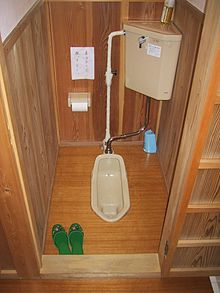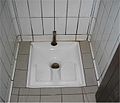- Squat toilet
-
 Toilet retrofit installation
Toilet retrofit installation
A squat toilet (also known as an Arabic, French, Chinese, Japanese, Korean, Iranian, Indian, Turkish or Natural-Position toilet) is a toilet used by squatting, rather than sitting. There are several types of squat toilets, but they all consist essentially of a hole in the ground. The only exception is a "pedestal" squat toilet, which is the same height as a standard flush toilet. It is also possible to squat over standard Western pedestal toilets, but this requires extra care as they are not specifically designed for squatting.[1]
Contents
Types of squat toilets
- The squat toilets are also known as alaturka (from Italian alla turca), Iranian Toilet, or kakkoos in Tamil. In contrast to alafranga (alla franca) (flush toilets) where the user puts their feet on foot rests; the user faces the entrance to the cubicle; it is prevalent in Turkey where flush toilets are just now becoming more common in households and can still be found in some public buildings and at motorway services in France, where almost 80% of Cafes still have squat toilets, Italy, Uruguay, Romania, Balkans and, more often, in the former USSR. In Argentina, Peru,and Bolivia, squat toilets can be found in older, lower class pubs, cafés and restaurants. It is also used in the Middle East and can be found in rural areas of Greece and Italy. It is also very common in Iran and prevalent throughout mainland China, Southeast Asia and South Asia.
- The toilets of Asia vary greatly. The Japanese toilet, which is also found in Korea, mainland China and Taiwan, is shaped differently with a rectangular or oval shape and a lip at the flushing end to guard against urine. The user squats facing the flushing apparatus with their stool being deposited on the dry section opposite the flushing end, eliminating splashing but allowing some odor. When flushed, the higher, dry section of the toilet is washed towards the pool of water at the flushing end. In countries such as mainland China, South East Asia, and several South Asian countries, there are rural poor regions in which the squatter toilet are nothing but a communal trough dug in the ground shared by many users. When this occurs, the trough is usually concrete and plumbing may be non-existent. When water isn't available in arid areas, a hole is dug in the ground, stool is disposed in it and it is then covered using soil.
Advantages of squat toilets
Some benefits of using squat toilets are:
- It is less expensive and easier to clean and maintain.[2]
- It does not involve any contact between the buttocks and thighs with a potentially unsanitary surface.[3]
- Squatting might help to build the required exhaust pressure more comfortably and quickly.[4]
- Squatting makes elimination faster, easier and more complete.[5]
- Elimination in squatting posture protects the nerves that control the prostate, bladder and uterus from becoming stretched and damaged.[6][unreliable source?]
- Squatting relaxes the puborectalis muscle which normally chokes the rectum in order to maintain continence.[7]
- Squatting securely seals the ileocecal valve, between the colon and the small intestine. In the conventional sitting position, this valve is unsupported and often leaks during evacuation.[8]
- For pregnant women, squatting avoids pressure on the uterus when using the toilet. Daily squatting helps prepare the mother-to-be for a more natural delivery.[9]
- Squatting may reduce the occurrence or severity of hemorrhoids[1][10] and possibly other colorectal disorders such as diverticulosis[11] and appendicitis.[12]
Gallery
-
A pedestal squat toilet found in Chiang Dao, Thailand
-
A stainless steel squat toilet found in public toilet of Victoria Park, Hong Kong
See also
- History of the toilet
References
- ^ a b Dimmer C, Martin B, Reeves N, Sullivan F (1996). "Squatting for the Prevention of Hemorrhoids?". Townsend Letter for Doctors & Patients (159): 66–70. http://www.uow.edu.au/arts/sts/bmartin/pubs/96tldp.html.
- ^ "Squatting Pan & Urinal Series.", a
- ^ "Squatting Pan & Urinal Series.", b
- ^ Bockus, H.L., GastroEnterology, (Philadelphia: W.B. Saunders Co., 1944), Vol. 2, p. 469.
- ^ Rad S (Apr 2002). "Impact of Ethnic Habits on Defecographic Measurements". Archives of Iranian Medicine 5 (2): 115–7. http://www.ams.ac.ir/AIM/0252/0252115.htm.
- ^ Tobin, Andrew.. Prostate Disorder – Causes and Cure, National Direct Publishing, Bowden, Australia, 1996, (Chapter 12, by Wallace Bowles, entitled "Refining an Everyday Activity"),p.132
- ^ Tagart RE (1966). "The anal canal and rectum: their varying relationship and its effect on anal continence". Dis Colon Rectum 9 (6): 449–52. doi:10.1007/BF02617443. PMID 5926158.
- ^ Welles, William, "The Importance of Squatting" chapter in Tissue Cleansing Through Bowel Management, Bernard Jensen Publisher; 10th Ed edition (June 1981).
- ^ Nasir A, Korejo R, Noorani KJ (Jan 2007). "Child birth in squatting position". J Pak Med Assoc 57 (1): 19–22. PMID 17319414.
- ^ Sikirov BA (Apr 1987). "Management of hemorrhoids: a new approach". Isr J Med Sci. 23 (4): 284–6. PMID 3623887. link
- ^ Sikirov BA (May 1988). "Etiology and pathogenesis of diverticulosis coli: a new approach". Med Hypotheses 26 (1): 17–20. doi:10.1016/0306-9877(88)90107-7. PMID 2840558.
- ^ Burkitt DP (Feb 1976). "A deficiency of dietary fiber may be one cause of certain colonic and venous disorders". Digestive Diseases and Sciences 21 (2): 104–8. doi:10.1007/BF01072052. PMID 1274909. http://www.springerlink.com/content/m84u825332110279/.
External links
- How to use a squat toilet
- Squatting for the Prevention of Hemorrhoids
- Health Benefits of the Natural Squatting Position
- Wikihow.com, How to Use a Squat Toilet
- Toilets of the World
Toilets Features Types See also Female urination device · Privatization of public toilets · Washroom attendant · Toilet paper orientation · History of sanitationCategories:- Toilet types
Wikimedia Foundation. 2010.










